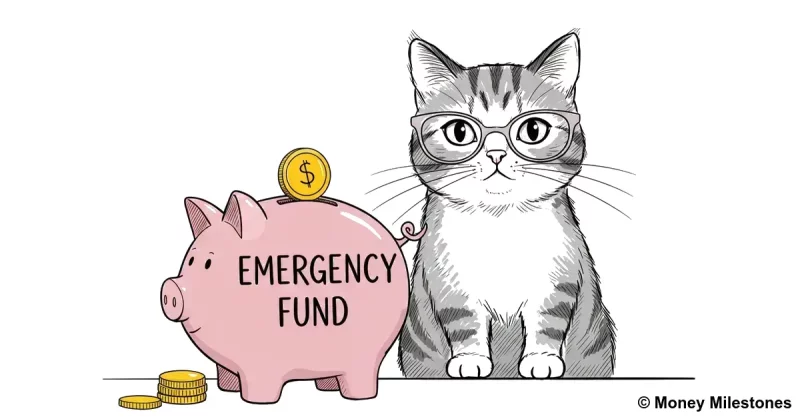The ultimate emergency fund guide
Your cousin Martha just told you that you need an emergency fund. But what exactly is it for? Should you really have one? And how much should you set aside? In this emergency fund guide, we’ll explain everything you need to know: what they’re for (and what they’re not for), how much you should have, and where to keep the money.
What an emergency fund is for
An emergency fund is money you set aside to cover unexpected expenses or a drop in income. Here are some examples of what it’s meant for:
- Your car breaks down and needs repairs
- Your boiler fails in the middle of winter
- You need urgent private medical care
- You’re made redundant
- If you’re self-employed, you struggle to find a new client or contract
These types of situations can (and likely will) happen at some point. The goal of an emergency fund is to help you avoid financial stress when unexpected events arise. Think of it as a self-insurance policy for life’s uncertainties.
What an emergency fund is not for
An emergency fund is not meant to cover everyday expenses or planned purchases. It’s there to protect you from unexpected, urgent situations. Here’s what your emergency fund should not be used for:
- Holidays or trips
- Non-urgent medical expenses
- Home improvements or upgrades
- Buying a new car
- Dining out or entertainment
The purpose of an emergency fund is to provide a financial cushion for those unexpected moments. If you dip into it for planned expenses, you might find yourself unprepared when a real emergency hits. Imagine paying for a holiday with your emergency fund, then coming home to find out you’ve lost your job. Without that safety net, you could be in a tough situation.
Why building an emergency fund should be your top priority
If you don’t already have an emergency fund, making one should be your first financial priority. It should come before investing or saving for other goals, such as buying new gadgets or even saving for retirement.
However, if you have high-interest debt (such as credit card debt or payday loans), it’s often best to pay it off first, or at least tackle it alongside building your emergency fund. The reason is simple: high-interest debt can quickly become a financial burden, and paying it off will help free up more money for saving later on.
If you’re struggling with debt, free and confidential advice is available from the National Debtline.
Emergency fund guide: how much money do you need?
The amount you need in your emergency fund depends on the safety level you’re aiming for. Before using the Money Milestones Emergency Fund calculator below to find your target amount, you’ll need to:
- Choose your safety level:
- Basic. The bare minimum for an emergency fund, covering 2 months of essential outgoings. If you’re starting with nothing, this is a good target to aim for.
- Normal. Provides a 3-month buffer. This is the most common target and offers more peace of mind for most people.
- Safe. Ideal if you have an irregular or unstable income. A 6-month cushion offers extra security in case of emergencies.
- List your main monthly outgoings:
- Housing. Your monthly rent or mortgage payment. Only include your share if you live with others.
- Utilities. Regular bills like gas, electricity, water, broadband, and mobile phone contracts.
- Food. Groceries, dining out, work lunches, etc.
- Other. Anything else essential, such as council tax, childcare, car costs, home insurance, subscriptions, etc.
Once you’ve worked out your monthly outgoings and chosen a safety level, use the calculator below (also available as a standalone tool here) to see how much you should have in your emergency fund.
Emergency fund guide: how to build it gradually
Now you know how much you should have in your emergency fund. Don’t panic if you don’t have that kind of money right now. You can build your emergency fund gradually by saving a little at a time.
Let’s say your target emergency fund is £5,000. You decide to put £50 aside each month in a savings account with an interest rate of 5%. It would take just under four years to reach your £5,000 target. Of course, if you save more, you’ll get there faster. Building your emergency fund should be your number one priority (after paying off high-interest debt), so put aside as much as you can until you hit your goal.
You can run the numbers with your own target and monthly contribution using my savings and investments growth calculator.
Emergency fund guide: common mistakes to avoid
There are several mistakes that could undermine the usefulness of your emergency fund. Here’s what to watch out for:
It must be easily accessible
Imagine you’re driving your brand-new car when suddenly, a pebble flies off the lorry in front of you and smashes your windshield. Fortunately, you’re not injured, but you need your car tomorrow, and you don’t want to ruin your insurance premium. You need to find £500 by the end of the day.
“That’s fine,” you think, “I can tap into my emergency fund to cover this.” You call your bank, only to realise that your money is locked in a notice account, and you can’t access it before a month. As a result, you can’t pay for the repairs and find yourself in a financially tricky situation.
This example shows that no matter how much money you have in your emergency fund, if it’s not easily accessible, it’s essentially useless. You should be able to access your emergency fund instantly, or at the very least, by the end of the day.
Your capital must be guaranteed
As discussed in my article about saving vs investing, one major advantage of investing is that it has the potential to grow your money faster over time (though this is not guaranteed). However, this comes with a risk: the value of investments can fluctuate significantly.
For example, if you have an emergency fund worth £5,000 and you decide to invest it in the stock market, you can’t be sure of its value in the future. It could be worth £2,500, or £10,000. There’s simply no way of predicting this. The problem? You may need to rely on your emergency fund during a market downturn, and if it’s invested in volatile assets, it might not be there when you need it.
That’s why it’s essential that your emergency fund is guaranteed to retain its value. To ensure your emergency fund serves its purpose, you should avoid investing it and keep it in a secure, low-risk account.
Where to keep your money
Alright, so your emergency fund needs to be both liquid and guaranteed. In practice, this means putting it in an account where you can access the money easily and where its value won’t go down. Here are your main options:
- A current account. This is as liquid as it gets: you can access your money instantly. But it’s not ideal because most current accounts offer little or no interest. That means your money will lose value over time due to inflation.
- An easy-access savings account. A better option. These accounts are still liquid and often come with decent interest rates. You can compare easy-access savings accounts here to find one with the highest rate. Make sure the bank you choose is covered by the FSCS, so your money is protected if the bank goes bust.
Where not to keep your money
Avoid the following types of accounts when storing your emergency fund:
- A notice account. These accounts require you to notify the bank several days (or even months) in advance before making a withdrawal. This defeats the purpose of an emergency fund.
- A fixed rate account. It might be tempting to use one, as they offer guaranteed and often higher interest rates than easy-access accounts. But your money is locked away for months or years, making it unsuitable for emergencies.
- Premium Bonds. These are often considered liquid, but it can still take 2–3 days for the money to reach your account. That’s too long in an emergency.
- Stocks. This includes investment accounts such as Stocks & Shares ISAs, General Investment Accounts, and more. Your capital is not guaranteed, and as explained earlier, that’s a major issue. Most investment platforms also won’t let you access your funds instantly, adding a liquidity problem on top.
- Gold. As I explain in my article about investing in gold, there are several ways to invest in it. But none of them guarantee your capital, since gold’s value fluctuates. Physical gold can also create liquidity issues, making it a poor choice for emergency savings.
- Crypto. Crypto is extremely volatile. £10,000 today could easily drop to £1,000 tomorrow. It’s the last place you should store your emergency fund.
Emergency fund guide: final thoughts
If you’re still reading, you’re now an emergency fund expert! You understand what an emergency fund is for, and just as importantly, what it isn’t for. You also know how much to save and how to build up your fund gradually. Finally, you know where to keep your emergency fund so that it stays accessible and guaranteed when you need it most.
If you found this article helpful, why not check out some of my other posts on Money Milestones? I’ve got plenty more tips to help you take charge of your financial future, like how to negotiate a pay rise or whether opting out of your workplace pension is a good idea.





